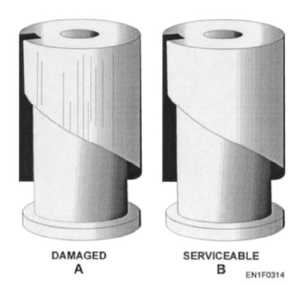ENGINEMAN 1 & C
During the overhaul of fuel injection equip-
ment, a spotlessly clean working space is essen-
tial for the protection of all parts. Ideally, the area
should also be air conditioned. All air should be
thoroughly filtered before it enters the space.
Benches should have smooth tops. Metal-topped
benches should be covered with linoleum or lint-
free rags. Ample quantities of approved cleaning
solvent, of clean fuel oil, and of compressed air
to blow parts dry, should be used to help ensure
cleanliness during overhaul. Never use rags or
waste to clean injectors, as lint particles from them
may damage the injector parts.
From the time a unit is removed from the
engine until it is replaced on the engine, extreme
care must be exerted to keep dust and dirt away
from all its parts. Before any connections are
Figure 3-14.—A damaged and serviceable plunger.
loosened, all dirt should be removed from the
unit, tubing, and fittings by washing. After
removal of the unit from the engine, all opening
(pump, nozzle, tubing, or injectors) should be
covered with approved caps or coverings.
Damage to the plunger of a fuel injection
pump or injector may be caused by such different
factors as entry of dirt into the equipment, careless
handling while the equipment is disassembled,
corrosion,
and improper assembly and
disassembly procedures.
Dirt and water are responsible for practically
all trouble encountered with fuel injection equip-
ment. If the units are not properly protected, they
can be damaged beyond repair within a very short
period of operation. Remember that the
clearances between the lapped surfaces are so
small that occasionally extremely fine particles,
such as dust from the atmosphere, are capable of
scoring these surfaces. Then small amounts of
water that may collect from condensation will cor-
rode these surfaces.
An engine should never be operated unless the
fuel has been properly filtered before reaching the
injection equipment. Although regular filters and
strainers are present in all fuel systems, in some
systems special safety filters or screens are incor-
porated to further reduce the possibility of foreign
matter mixing with the fuel as it reaches the pump
and the injector. The location of these additional
safety devices depends upon the system. In one
system a screen is placed between the fuel transfer
pump and the fuel distributor, while in another
a filter is mounted directly on the pump.
Because many surfaces of the parts of pumps
and injectors are lapped to extremely accurate
finishes, it is essential that they be HANDLED
WITH GREAT CARE. Parts that are dropped
may be bent, nicked, dented, or otherwise
ruined. All work should be done well over the
center of the bench. The use of a linoleum cover-
ing will reduce casualties caused by dropping parts
on the bench. Never leave parts uncovered on the
bench, but keep them immersed in diesel fuel until
handled. Never handle lapped surfaces when they
are dry, as the perspiration on your hands may
cause corrosion. Before a lapped surface is
handled, it should be immersed in clean diesel
fuel, and the hands rinsed in clean fuel. Since the
mating parts of pumps and injectors are fitted to
one another, such parts as plunger and barrel
should be kept together to avoid interchanging.
Since water in the fuel, or improper storage
of parts, can also cause CORROSION of the parts
of a pump or an injector, all fuel should be cen-
trifuged, and filter and strainer cases drained
periodically to prevent excessive collection of
water. Information on proper stowage procedures
should be obtained from the appropriate technical
manual.
3-18

